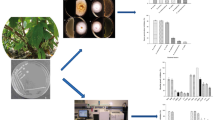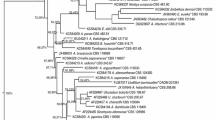Abstract
The co-culture of plant beneficial microbes to stimulate the production of antimicrobial metabolites is gaining ground. Here, the inactivated Colletotrichum gloeosporioides mycelium was used to induce the biosynthesis of antifungal compounds in the co-culture systems of Trichoderma sp. and Bacillus subtilis. The hexanic extracts obtained from the co-culture systems were tested against C. gloeosporioides. Those that inhibited the phytopathogen growth were further fractionated by column and thin-layer chromatography and analyzed by gas chromatography coupled to mass spectrometry (GC–MS). Ethyl butanoate, butyl acetate, acetic acid, 2-butoxyethanol, 3,5-di-tert-butyl-4-hydroxybenzaldehyde, 3,5-di-tert-butyl-4-hydroxybenzyl alcohol, hexadecanoic acid, and octadecanoic acid were identified. Butyl acetate was the most abundant compound, and its application affected the morphology and mycelial development of C. gloeosporioides, thereby inhibiting the radial growth, reducing spore formation, and inducing soft colonies. We conclude that co-culturing Trichoderma sp. and B. subtilis promotes the production of novel diffusible organic compounds with an antifungal effect on C. gloeosporioides.








Similar content being viewed by others

References
Abdelshafy Mohamad OA, Ma JB, Liu YH, Zhang D, Hua S, Bhute S et al (2020) Beneficial endophytic bacterial populations associated with medicinal plant Thymus vulgaris alleviate salt stress and confer resistance to Fusarium oxysporum. Front Plant Sci 11:47. https://doi.org/10.3389/fpls.2020.00047
Araújo RG, Rodriguez-Jasso RM, Ruiz HA, Pintado MME, Aguilar CN (2018) Avocado by-products: nutritional and functional properties. Trends Food Sci Technol. https://doi.org/10.1016/j.tifs.2018.07.027
Arjona-Girona I, Vinale F, Ruano-Rosa D, Lorito M, López-Herrera CJ (2014) Effect of metabolites from different Trichoderma strains on the growth of Rosellinia necatrix, the causal agent of avocado white root rot. Eur J Plant Pathol 140(2):385–397. https://doi.org/10.1007/s10658-014-0472-z
Ashwini N, Srividya S (2014) Potentiality of Bacillus subtilis as biocontrol agent for management of anthracnose disease in chilli caused by Colletotrichum gloeosporioides OGC1. 3Biotech 4(2):127–136. https://doi.org/10.1007/s13205-013-0134-4
Avis TJ (2007) Antifungal compounds that target fungal membranes: applications in plant disease control. Can J Plant Path 29(4):323–329. https://doi.org/10.1080/07060660709507478
Ayala Silva T, Ledesma N (2014) Avocado history, biodiversity and production. In: Nandwani D (ed) Sustainable horticultural systems. Sustainable development and biodiversity, vol 2. Springer, Cham, pp 157–205. https://doi.org/10.1007/978-3-319-06904-3_8
Bae SJ, Mohanta TK, Chung JY, Ryu M, Park G, Shim S et al (2016) Trichoderma metabolites as biological control agents against Phytophthora pathogens. Biol Control 92:128–138. https://doi.org/10.1016/j.biocontrol.2015.10.005
Brown SH, Yarden O, Gollop N, Chen S, Zveibil A, Belausov E, Freeman S (2008) Differential protein expression in Colletotrichum acutatum: Changes associated with reactive oxygen species and nitrogen starvation implicated in pathogenicity on strawberry. Mol Plant Pathol 9:171–190. https://doi.org/10.1111/j.1364-3703.2007.00454.x
Chellappandian M, Thanigaivel A, Vasantha-Srinivasan P, Edwin ES, Ponsankar A, Selin-Rani S, Kalaivani K, Senthil-Nathan S, Benelli G (2018) Toxicological effects of Sphaeranthus indicus Linn. (Asteraceae) leaf essential oil against human disease vectors, Culex quinquefasciatus Say and Aedes aegypti Linn., and impacts on a beneficial mosquito predator. Environ Sci Pollut Res 25:10294–10306. https://doi.org/10.1007/s11356-017-8952-2
Contreras-Cornejo HA, Macías-Rodríguez L, Cortés-Penagos C, López-Bucio J (2009) Trichoderma virens, a plant benefical fungus, enhances biomass production and promotes lateral root growth through an auxin-dependent mechanism in Arabidopsis. Plant Physiol 149(3):1579–1592. https://doi.org/10.1104/pp.108.130369
Darvas J, Kotze J (1987) Fungi associated with pre-and postharvest diseases of avocado fruit at Westfalia Estate, South Africa. Phytophylactica 19:83–85
de Souza JRB, Kupper KC, Augusto F (2018) In vivo investigation of the volatile metabolome of antiphytopathogenic yeast strains active against Penicillium digitatum using comprehensive two-dimensional gas chromatography and multivariate data analysis. Microchem J 141:362–368. https://doi.org/10.1016/j.microc.2018.05.047
FAOSTAT (2017) Agricultural avocado statistics: area harvested, yield and production quantity. http://www.fao.org/faostat/en/#data/QC. Accessed 1 Sept 2019
Fira D, Dimkić I, Berić T, Lozo J, Stanković S (2018) Biological control of plant pathogens by Bacillus species. J Biotechnol 285:44–55. https://doi.org/10.1016/j.jbiotec.2018.07.044
Fraire-Velázquez S, Rodríguez-Guerra R, Sánchez-Calderón L (2011) Abiotic and biotic stress response crosstalk in plants. In: Shanker A (ed) Abiotic stress response in plants - physiological, biochemical and genetic perspectives. Intech Open. https://doi.org/10.5772/23217
Gajbhiye A, Rai AR, Meshram SU, Dongre AB (2010) Isolation, evaluation and characterization of Bacillus subtilis from cotton rhizospheric soil with biocontrol activity against Fusarium oxysporum. World J Microbiol Biotechnol 26(7):1187–1194. https://doi.org/10.1007/s11274-009-0287-9
Gerbore J, Benhamou N, Vallance J, Le Floch G, Grizard D, Regnault-Roger C, Rey P (2014) Biological control of plant pathogens: advantages and limitations seen through the case study of Pythium oligandrum. Environ Sci Pollut Res 21:4847–4860. https://doi.org/10.1007/s11356-013-1807-6
Guetsky R, Kobiler I, Wang X, Perlman N, Gollop N, Avila-Quezada G, Hadar I, Prusky D (2005) Metabolism of the flavonoid epicatechin by laccase of Colletotrichum gloeosporioides and its effect on pathogenicity on avocado fruits. Phytopathology 95:1341–1348. https://doi.org/10.1094/PHYTO-95-1341
Guzmán-Guzmán P, Porras-Troncoso MD, Olmedo-Monfil V, Herrera-Estrella A (2019) Trichoderma species: Versatile plant symbionts. Phytopathology 109(1):6–16. https://doi.org/10.1094/PHYTO-07-18-0218-RVW
He P, Wang Y, Wang X, Zhang X, Tian C (2017) The mitogen-activated protein kinase CgMK1 governs appressorium formation, melanin synthesis, and plant infection of Colletotrichum gloeosporioides. Front Microbiol 8:2216. https://doi.org/10.3389/fmicb.2017.02216
Hirpara DG, Gajera HP, Bhimani RD, Golakiya BA (2016) The SRAP based molecular diversity related to antifungal and antioxidant bioactive constituents for biocontrol potentials of Trichoderma against Sclerotium rolfsii Scc. Curr Genet 62:619–641. https://doi.org/10.1007/s00294-016-0567-5
Jambhulkar PP, Sharma P, Manokaran R, Lakshman DK, Rokadia P, Jambhulkar N (2018) Assessing synergism of combined applications of Trichoderma harzianum and Pseudomonas fluorescens to control blast and bacterial leaf blight of rice. Eur J Plant Pathol 152(3):747–757. https://doi.org/10.1007/s10658-018-1519-3
Joshi R, McSpadden Gardener BB (2006) Identification and characterization of novel genetic markers associated with biological control activities in Bacillus subtilis. Phytopathology 96(2):145–154. https://doi.org/10.1094/PHYTO-96-0145
Kim J, Marshall MR, Wei CI (1995) Antibacterial activity of some essential oil components against five foodborne pathogens. J Agricult Food Chem 43(11):2839–2845
Kumar M, Ashraf S (2017) Role of trichoderma spp. as a biocontrol agent of fungal plant pathogens. In: Kumar V, Kumar M, Sharma S, Prasad R (eds) Probiotics and plant health. Springer, Singapore, pp 497–506. https://doi.org/10.1007/978-981-10-3473-2_23
Kumar R, Ghatak A, Balodi R, Bhagat AP (2018) Decay mechanism of postharvest pathogens and their management using non-chemical and biological approaches. J Postharvest Technol 06:1–11
Li Q, Wu L, Hao J, Luo L, Cao Y, Li J (2015) Biofumigation on post-harvest diseases of fruits using a new volatile-producing fungus of Ceratocystis fimbriata. PLoS ONE 10:e0132009. https://doi.org/10.1371/journal.pone.0132009
Liu F, Zhan RL, He YB, Zhao YL, Yang SJ, Chang JM (2011) Mechanism of biological control to anthracnoses in mango by antimicrobial Cinnamaldehyde. J Fruit Sci 28(4):651–656
Liu ZQ, Wu ML, Ke ZJ, Liu WB, Li XY (2018) Functional analysis of a regulator of G-protein signaling CgRGS1 in the rubber tree anthracnose fungus Colletotrichum gloeosporioides. Arch Microbiol 200(3):391–400. https://doi.org/10.1007/s00203-017-1455-1
Mohammadipour M, Mousivand M, Jouzani GS, Abbasalizadeh S (2009) Molecular and biochemical characterization of Iranian surfactin-producing Bacillus subtilis isolates and evaluation of their biocontrol potential against Aspergillus flavus and Colletotrichum gloeosporioides. Can J Microbiol 55:395–404. https://doi.org/10.1139/W08-141
Pal KK, Gardener BM (2006) Biological control of plant pathogens. Plant Health Instructor Biol Control 7:1–25. https://doi.org/10.1094/PHI-A-2006-1117-02
Pernezny K, Glade B, Marlatt RB (2000) Diseases of avocado in Florida. Plant Pathology Fact Sheet. https://plantpath.ifas.ufl.edu/misc/media/factsheets/pp0021.pdf. Accesed 19 May 2019
Rojo-Báez I, Álvarez-Rodríguez B, García-Estrada RS, León-Félix J, Sañudo-Barajas A, Allende-Molar R (2017) Situación actual de Colletotrichum spp. en México: taxonomía, caracterización, patogénesis y control. Rev Mex Fitopatol Mex J Phytopathol 35:549–570. https://doi.org/10.18781/r.mex.fit.1703-9
Sharma RR, Singh D, Singh R (2009) Biological control of postharvest diseases of fruits and vegetables by microbial antagonists. Rev Control Biol. https://doi.org/10.1016/j.biocontrol.2009.05.001
Sharma V, Salwan R, Sharma PN, Kanwar SS (2017) Elucidation of biocontrol mechanisms of Trichoderma harzianum against different plant fungal pathogens: universal yet host specific response. Int J Biol Macromol 95:72–79. https://doi.org/10.1016/j.ijbiomac.2016.11.042
SIAP (2019) Boletín mensual de producción de Aguacate, SADER. https://www.gob.mx/cms/uploads/attachment/file/504481/Bolet_n_avance_de_producci_n_de_Aguacate_septiembre_2019.pdf. Accessed 1 Sept 2019
Siddiquee S, Cheong BE, Taslima K, Kausar H, Hasan MM (2012) Separation and identification of volatile compounds from liquid cultures of Trichoderma harzianum by GC-MS using three different capillary columns. J Chromatogr Sci 50:358–367. https://doi.org/10.1093/chromsci/bms012
Singh N, Pandey P, Dubey RC, Maheshwari DK (2008) Biological control of root rot fungus Macrophomina phaseolina and growth enhancement of Pinus roxburghii (Sarg.) by rhizosphere competent Bacillus subtilis BN1. World J Microbiol Biotechnol 24(9):1669. https://doi.org/10.1007/s11274-008-9680-z
Singh RK, Kukrety A, Sharma OP, Poddar MK, Atray N, Ray SS (2017) Synthesis of a novel efficient antioxidant for use in lubes and biodiesel. Pet Chem 57:100–105. https://doi.org/10.1134/S096554411701011X
Trinidad-Ángel E, Ascencio-Valle FDJ, Ulloa OA, Ramírez-Ramíre OC, Ragazzo-Sánchez JA, Calderón-Santoyo M, Bautista Rosales PU (2017) Identificación y caracterización de Colletotrichum spp. causante de antracnosis en aguacate de Nayarit, México. Rev Mex Ciencias Agrícolas. https://doi.org/10.29312/remexca.v0i19.664
Wang X, Xu X, Liang Y, Wang Y, Tian C (2018) A Cdc42 homolog in Colletotrichum gloeosporioides regulates morphological development and is required for ROS-mediated plant infection. Curr Genet 64(5):1153–1169. https://doi.org/10.1007/s00294-018-0833-9
Wei Y, Pu J, Zhang H, Liu Y, Zhou F, Zhang K, Liu X (2017) The laccase gene (LAC1) is essential for Colletotrichum gloeosporioides development and virulence on mango leaves and fruits. Physiol Mol Plant Pathol 99:55–64. https://doi.org/10.1016/j.pmpp.2017.03.005
Wightwick A, Walters R, Allinson G, Reichman S, Menzies N (2010) Environmental risks of fungicides used in horticultural production systems. In: Odise C (ed) Fungicides, 1st edn. InTech, Rijeka, pp 273–304. https://doi.org/10.5772/13032
Willingham SL, Pegg KG, Coates LM, Cooke AW, Dean JR, Langdon PWB, Beasley DR (2001) Field management of avocado postharvest diseases. In: Ben-Arie R, Philosoph-Hadas S (eds) Acta horticulturae, 1st edn. International Society for Horticultural Science (ISHS), Leuven, pp 435–438
Yang HH, Yang SL, Peng KC, Lo CT, Liu SY (2009) Induced proteome of Trichoderma harzianum by Botrytis cinerea. Mycol Res 113(9):924–932. https://doi.org/10.1016/j.mycres.2009.04.004
Yuan J, Zhao M, Li R, Huang Q, Raza W, Rensing C, Shen Q (2017) Microbial volatile compounds alter the soil microbial community. Environ Sci Pollut Res 24:22485–22493. https://doi.org/10.1007/s11356-017-9839-y
Živković S, Stojanović S, Ivanović Ž, Gavrilović V, Popović T, Balaž J (2010) Screening of antagonistic activity of microorganisms against Colletotrichum acutatum and Colletotrichum gloeosporioides. Arch Biol Sci 62(3):611–623. https://doi.org/10.2298/ABS1003611Z
Zentmyer GA (1984) Avocado diseases trop. Pest Manag 30:388–400. https://doi.org/10.1080/09670878409370915
Acknowledgements
The strains used were kindly donated: Trichoderma T1 and T3 by Juan Boyzo Marín, Trichoderma T2 by M.C. Alberto Flores García from Instituto de Investigaciones Químico Biológicas (IIQB-UMSNH), and the phytopathogenic fungus C. gloeosporioides by Dra. Silvia Patricia Hernández Pavia from Instituto de Investigaciones Agropecuarias y Forestales (IIAF-UMSNH). Manuscript editing was supported by Conacyt, grant No. 222405.
Author information
Authors and Affiliations
Contributions
R-VE conducted the experiments and analyzed the results, P-UCA contributed to study design and edited the manuscript, M-RLI conducted the GC–MS analyses, RCH edited, reviewed and approved the version to be published. C-AMN contributed to overall study design and discussion and edited the manuscript; all authors read and reviewed the manuscript.
Corresponding authors
Ethics declarations
Conflict of interest
The authors declare that they have no conflict of interest.
Ethical statement
This article does not contain any studies with human participants or animals performed by any of the authors.
Electronic supplementary material
Below is the link to the electronic supplementary material.
13205_2020_2324_MOESM1_ESM.pdf
Supplementary file1 (PDF 184 kb) Fractions obtained by using column chromatography of hexanic extracts from each co-inoculation system
Rights and permissions
About this article
Cite this article
Emanuel, RV., César Arturo, PU., Lourdes Iveth, MR. et al. In vitro growth of Colletotrichum gloeosporioides is affected by butyl acetate, a compound produced during the co-culture of Trichoderma sp. and Bacillus subtilis. 3 Biotech 10, 329 (2020). https://doi.org/10.1007/s13205-020-02324-z
Received:
Accepted:
Published:
DOI: https://doi.org/10.1007/s13205-020-02324-z



